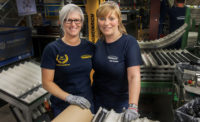In automotive applications, PSAs offer several advantages compared with mechanical fasteners. They bond instantly. They distribute stress across the entire bonded area. They obviate the need to drill or tap holes. They improve aesthetics by eliminating protrusions, such as rivets or screw heads. They absorb sound and vibration. And, they seal out water and dust.
It’s ironic, then, that PSAs don’t immediately spring to mind when engineers ponder assembly of power train applications. In fact, however, manufacturers have long been using a special class of PSAs, known as nitrile-phenolic films, to assemble brake and transmission components for cars, motorcycles, buses, tractors, lawn and garden equipment, and industrial machinery. These films also see use in the aerospace, electronics, furniture and footwear industries.
Nitrile-phenolic films are dry, heat-activated adhesives that strongly and permanently bond wet-laid fiber, carbon and other friction materials to various metallic and nonmetallic substrates, including steel, stainless steel, aluminum, titanium and brass. Shear strengths in excess of 4,500 psi can be accomplished with these films through moderate application of heat and pressure.
The films cross-link when exposed to temperatures greater than 300 F, transitioning from thermoplastic materials to thermoset materials. This creates a strong bond that is unaffected by later exposure to temperature extremes once the adhesive solidifies.
Nitrile-phenolic films exhibit excellent plastic flow, resulting in 100 percent contact between the substrates. Highly customizable, they can be formulated to suit specific materials or applications.
The films are extremely resistant to heat and chemicals, making them ideal for friction-related automotive applications, such as motors, transmissions, clutches, brakes, limited-slip differentials, pressure plates and synchronizers. Due to their environmental resistance, these adhesives are frequently used to assemble torque converters and wet brakes, which are exposed to severe levels of heat, friction and chemicals, such as transmission oil.
Applying Dry Films
Nitrile-phenolic films are typically delivered in the form of dry adhesive tapes backed by a release liner for easy assembly and transfer to mating surfaces. Tapes are available in a range of thicknesses, depending on the application. For automotive applications, films come in thicknesses of 1 to 3 mils. Films for aerospace applications can be as thick as 12 mils.
The tapes can be produced in any width, and they can be die-cut to match the shape of a specific part.
To maximize shelf-life, nitrile-phenolic films should be stored under cool, dry conditions (70 F or less). The film should be used within 15 months of their coating date.
The surfaces to be bonded should be free of rust, grease, oil or foreign matter. For metallic surfaces, this may be accomplished by shot-blasting or chemical etching. Nonmetallic surfaces may be wiped down with a clean rag saturated with an oil-free solvent, such as acetone.
Bonding is accomplished using a press with heated tooling. The adhesive is initially transferred from the protective release liner to one of the substrates with the use of modest heat (approximately 240 F).
Once the mating part is in place, complete cure of the adhesive can be obtained with any of the following bond-line temperatures and times:
350 F for 30 minutes.
370 F for 20 minutes.
400 F for 10 minutes.
Shorter cures are possible at higher temperatures. However, setting the cure requires experience and must be established based on available equipment and the substrates.
Constant pressure is essential throughout the cure cycle. The pressure should be sufficient to bring the surfaces into intimate contact. The typical pressure range is 50 to 250 psi.
Films vs. Liquid Adhesives
Although nitrile-phenolic adhesives are available as dry films or solvent-based liquids, films are a better option for several reasons.
For one, dry film adhesives are easier to handle than liquid adhesives. Liquid adhesives are messy. Besides being a nuisance, clean-up of adhesive residues requires extra labor and can result in downtime. It may even necessitate off-line application of the adhesive. Nitrile-phenolic films are coated to a release liner for simple, mess-free assembly.
Liquid adhesives cannot be applied to a precise thickness. Too little adhesive can lead to debonding. Too much can cause premature failure or overflow onto critical components. Nitrile-phenolic films are produced at precise thickness tolerances.
Liquid adhesives require lengthy curing times, often as long as 24 hours. In comparison, a nitrile-phenolic film bonds in minutes. No extended curing time is necessary.
Dry film adhesives produce less waste than liquid adhesives. Since they are available premeasured for in-line application to raw materials and converted parts, dry film tapes ensure that just enough adhesive is applied for consistent bond strength. Liquid adhesives cannot be applied to a precise thickness, especially when manual coating is necessary. Any excess material applied to the part is wasted.
Safety is a significant advantage of nitrile-phenolic films. By their nature, solvent-based liquid adhesives contain significant amounts of volatile organic compounds (VOCs)—chemicals that can have short- and long-term adverse health effects. Since federal and state environmental and safety regulations limit VOC emissions, manufacturers may be required to purchase oxidizing equipment or install special ventilation to guarantee worker safety. Nitrile-phenolic films are typically very low in VOCs.
Similarly, proper disposal of hazardous waste drums is also a concern for manufacturers using liquid adhesives. Shipping and storage can also be a challenge with solvent-based adhesives, since some materials must be shipped under highly controlled conditions.
Dry film adhesives require no specialized shipping conditions and have a shelf life of up to 24 months once exposed to air. Liquid adhesives have a shelf life of five to 10 days.
Nitrile-phenolic film adhesives perform well in the toughest applications. As with any adhesive, it’s important to understand the details of each application to make an informed decision. Engineers should consider the substrates, performance requirements and environmental factors when determining the correct bonding method to pursue. In the right applications, substituting a nitrile-phenolic film for mechanical fasteners or solvent-based adhesive may yield significant savings.




